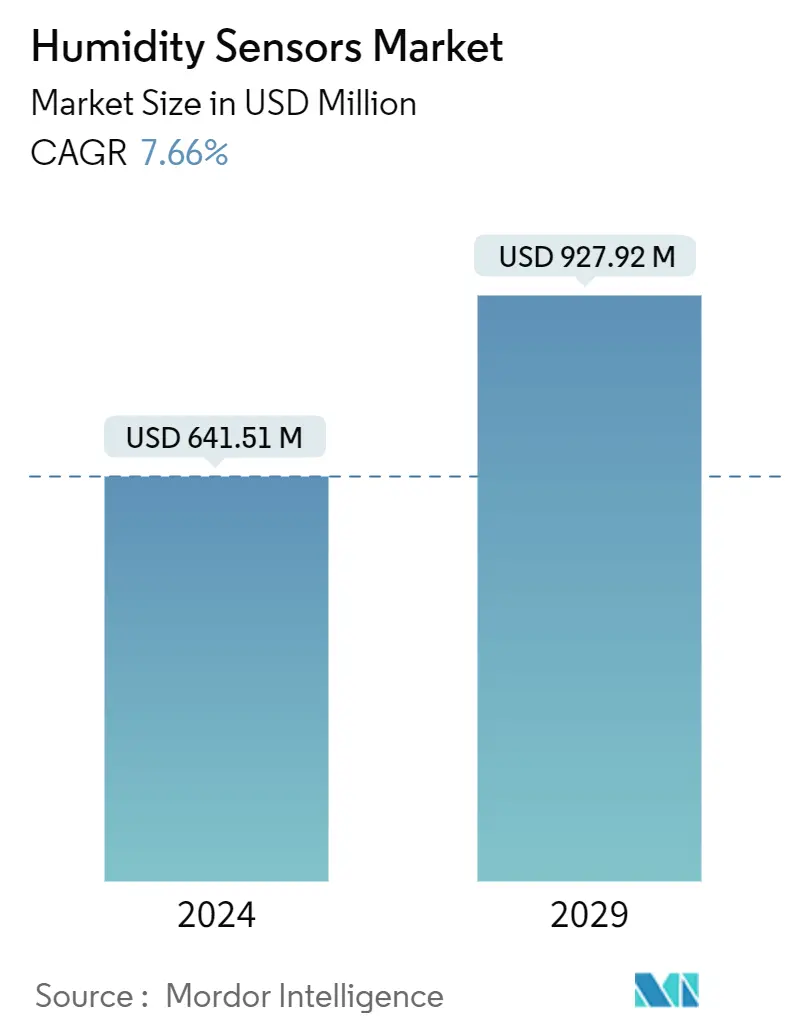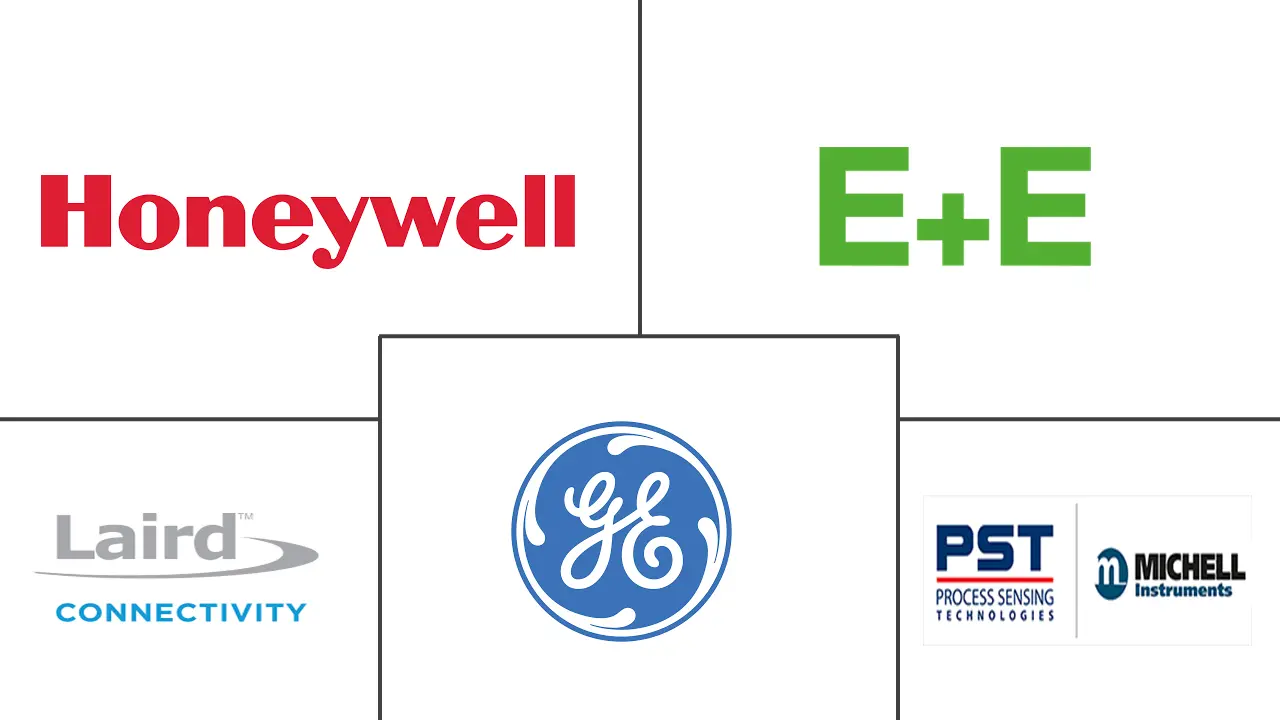Market Size of Humidity Sensors Industry

| Study Period | 2019 - 2029 |
| Market Size (2024) | USD 641.51 Million |
| Market Size (2029) | USD 927.92 Million |
| CAGR (2024 - 2029) | 7.66 % |
| Fastest Growing Market | Asia Pacific |
| Largest Market | Asia Pacific |
Major Players
*Disclaimer: Major Players sorted in no particular order |
Humidity Sensors Market Analysis
The Humidity Sensors Market size is estimated at USD 641.51 million in 2024, and is expected to reach USD 927.92 million by 2029, growing at a CAGR of 7.66% during the forecast period (2024-2029).
A humidity sensor is an electronic device that measures the humidity in its environment and converts its findings into a corresponding electrical signal. It comes in various sizes and functions; some are built into handheld devices, while others are part of larger embedded systems (such as air quality monitoring systems). Humidity sensors have wide use in meteorology, medicine, automobiles, HVAC, and industrial production. Some advantages to capacitive sensors include low power consumption, good linearity, and wide-range RH detection, but a complicated fabrication process is a major drawback.
- A humidity sensor’s performance is primarily determined by its nano- and microscopic structure, which includes pore size, layer thickness, size distribution of the surface structural element, surface morphology uniformity, and electrode distance. For implementation, humidity sensors must meet a variety of characteristics, including repeatability, sensitivity, reproducibility, linearity, low hysteresis, fast response-recovery speed, stability, low cost, and ease of connection to control units. Sensors should be designed according to these specifications.
- Humidity sensors can improve performance, reduce energy consumption, and increase safety in a variety of applications. Increasingly, OEMs are designing relative humidity/temperature sensors into engines, electronics, and other products to improve control and output.
- The automotive industry has grown significantly in the past few years, aided by the growth in unit volumes with the emergence of new technologies, whether it be for safety, entertainment, or pure innovation. Government organizations in many countries are implementing safety and emission control standards mandating the installation of sensors. Automotive companies are, thereby, required to comply with the safety and emission control regulations set by these authorities. This trend is expected to increase the demand for automotive temperature sensors over the forecast period.
- However, wireless sensors are vulnerable to various attacks, such as eavesdropping, jamming, and spoofing. They can be susceptible to interference from other wireless devices or radio signals, which can degrade the quality of data transmission. Thus, ensuring the security of the network and the data it collects poses a significant challenge to the market studied. In addition to this, they are typically small and have limited processing and storage capabilities. This makes it challenging to perform complex tasks or store large amounts of data.
- Due to the outbreak of COVID-19, the global supply chain and demand for multiple products have majorly been disrupted, and wireless humidity sensor adoption is anticipated to be influenced until the end of 2020. However, the growing demand for consumer electronics and medical applications significantly increased market growth. Various players were investing and collaborating to cater to the requirements.
Humidity Sensors Industry Segmentation
A humidity sensor is an electronic device that measures the humidity in its environment and converts its findings into a corresponding electrical signal. Humidity sensors are a part of environmental sensors.
The humidity sensors market is segmented by end-user industry (chemical and petrochemical, building automation (HVAC), automotive, oil and gas and natural gas, pharmaceutical, semiconductor, power generation, food and beverage, paper and pulp, water, wastewater, incineration, consumer electronics, and other end-user industries) and geography (North America, Europe, Asia-Pacific, Latin America, and Middle East & Africa). The market size and forecasts are provided in terms of value (USD) for all the segments mentioned above.
| By End-user Industry | |
| Chemical and Petrochemical | |
| Building Automation (HVAC) | |
| Automotive | |
| Oil and Gas and Natural Gas | |
| Pharmaceutical | |
| Semiconductor | |
| Power Generation | |
| Food and Beverage | |
| Paper and Pulp | |
| Water, Wastewater, and Incineration | |
| Consumer Electronics | |
| Other End-user Industries |
| By Geography | |
| North America | |
| Europe | |
| Asia-Pacific | |
| Latin America | |
| Middle East and Africa |
Humidity Sensors Market Size Summary
The humidity sensor market is poised for significant growth, driven by its critical applications across various industries such as automotive, HVAC, and consumer electronics. These sensors, which measure and convert humidity levels into electrical signals, are integral to enhancing performance, safety, and energy efficiency in numerous settings. The automotive sector, in particular, is witnessing increased demand for humidity sensors due to stringent safety and emission regulations, which necessitate their integration into vehicles for climate control and window defogging. The HVAC industry, fueled by infrastructure development and technological advancements, is also a major consumer of these sensors, as they play a vital role in maintaining air quality and energy efficiency. The Asia-Pacific region is expected to be a key growth area, with its robust manufacturing capabilities and increasing adoption of sensor technology in various applications.
The market landscape is characterized by fragmentation and intense competition, with numerous players investing in innovation and strategic collaborations to enhance their product offerings. Companies like E+E Elektronik, Honeywell International, and General Electric are at the forefront, introducing advanced sensors tailored for specific applications. The COVID-19 pandemic and geopolitical events have posed challenges, such as supply chain disruptions, but have also spurred growth in sectors like consumer electronics and healthcare, further propelling market expansion. As industries continue to embrace automation, IoT, and AI, the demand for high-performance humidity sensors is expected to rise, offering lucrative opportunities for market participants.
Humidity Sensors Market Size - Table of Contents
-
1. MARKET INSIGHTS
-
1.1 Market Overview
-
1.2 Industry Attractiveness - Porter's Five Forces Analysis
-
1.2.1 Bargaining Power of Suppliers
-
1.2.2 Bargaining Power of Buyers
-
1.2.3 Threat of New Entrants
-
1.2.4 Threat of Substitutes
-
1.2.5 Intensity of Competitive Rivalry
-
-
1.3 Impact of COVID-19 Aftereffects and other Macroeconomic Factors on the Market
-
1.4 Major Technology Types Infrared, Bimetallic, Cooled Mirror, and Aluminums Oxide Capacitive, among others
-
1.4.1 Major Technology Types - Infrared
-
1.4.2 Major Technology Types - Bimetallic
-
1.4.3 Major Technology Types - Cooled Mirror
-
1.4.4 Major Technology Types - Aluminum Oxide Capacitive
-
-
-
2. MARKET SEGMENTATION
-
2.1 By End-user Industry
-
2.1.1 Chemical and Petrochemical
-
2.1.2 Building Automation (HVAC)
-
2.1.3 Automotive
-
2.1.4 Oil and Gas and Natural Gas
-
2.1.5 Pharmaceutical
-
2.1.6 Semiconductor
-
2.1.7 Power Generation
-
2.1.8 Food and Beverage
-
2.1.9 Paper and Pulp
-
2.1.10 Water, Wastewater, and Incineration
-
2.1.11 Consumer Electronics
-
2.1.12 Other End-user Industries
-
-
2.2 By Geography
-
2.2.1 North America
-
2.2.2 Europe
-
2.2.3 Asia-Pacific
-
2.2.4 Latin America
-
2.2.5 Middle East and Africa
-
-
Humidity Sensors Market Size FAQs
How big is the Humidity Sensors Market?
The Humidity Sensors Market size is expected to reach USD 641.51 million in 2024 and grow at a CAGR of 7.66% to reach USD 927.92 million by 2029.
What is the current Humidity Sensors Market size?
In 2024, the Humidity Sensors Market size is expected to reach USD 641.51 million.

